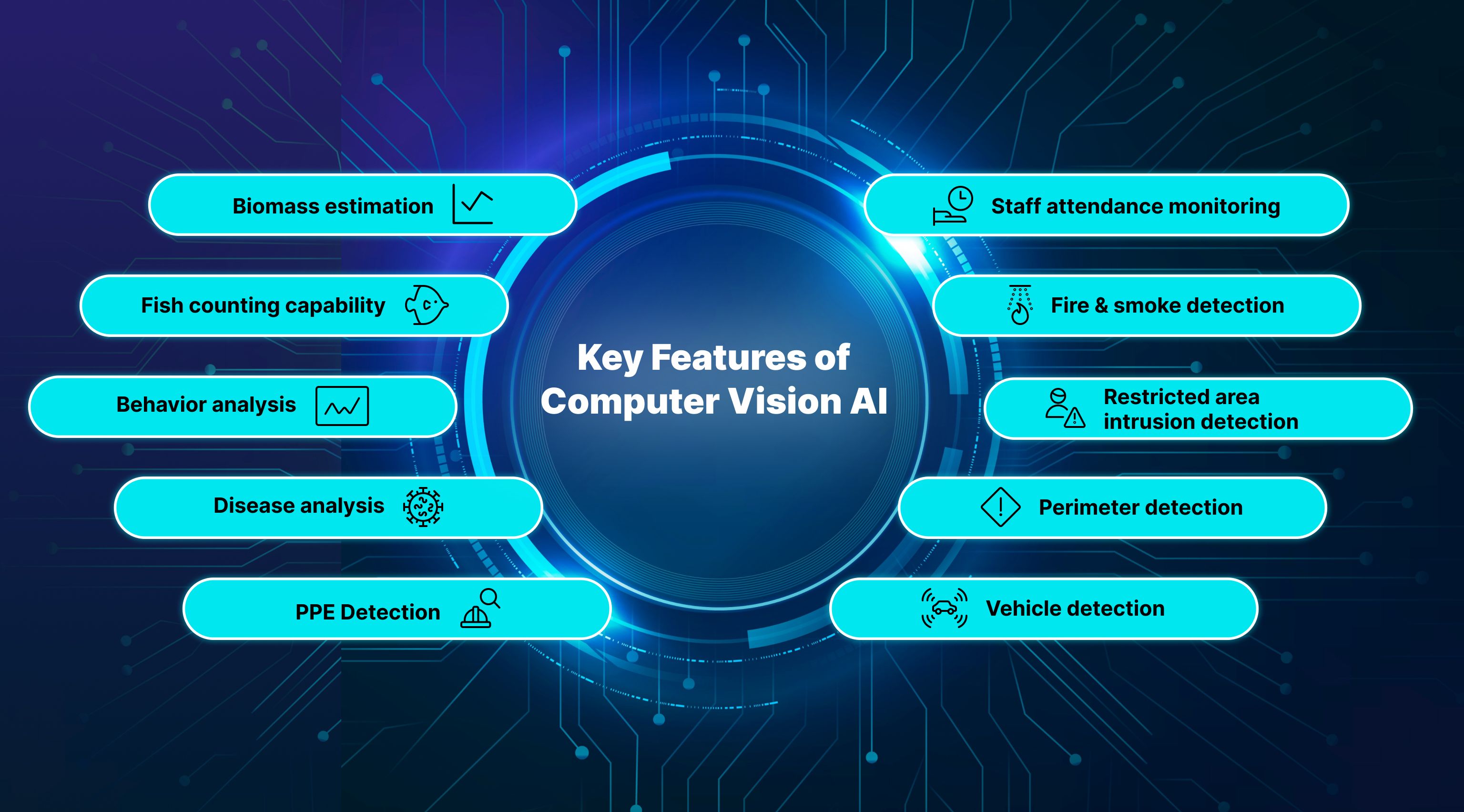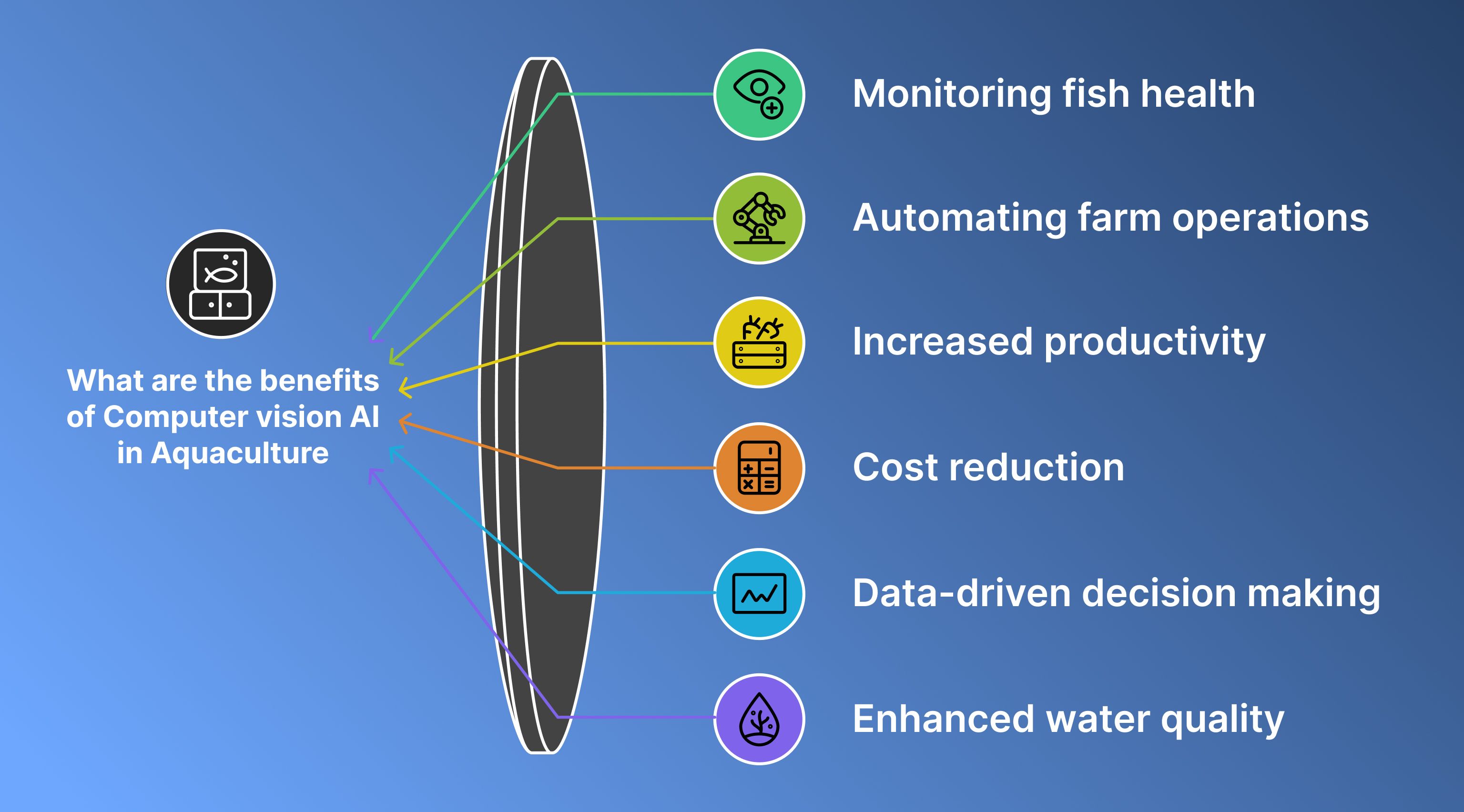Leveraging Computer vision AI for fish and prawn farms in aquaculture ecosystem

As per the latest statistics, it is estimated that the aquaculture industry is ranging USD 282 billion global business which is yielding 122.6 million tons of aquatic produce in recent times. Within a fish and prawn farming ecosystem, continuous monitoring of the average weight and size distribution of prawns in aquaculture is relevant to optimizing and harvesting strategies. The combination of machine learning and computer vision can detect prawn distribution and growth from feed trays. In this blog post, we are going to shed a major focus on computer vision AI and how it has transformed the aquaculture processes. Computer vision is proving beneficial for fish and prawn aquaculture with real-time monitoring and early detection of issues. AI video surveillance cameras are well-equipped with tools that maximize operational efficiency and improve security compliance in aquaculture management.
Key Features of Computer Vision AI
Computer vision AI comes with a wide range of features that make it the best choice for real-time monitoring of aquatic animals.

Biomass estimation
AI-powered camera surveillance can easily estimate the total biomass of the aquatic population. It effectively monitors entire biomass for preservation.
Fish counting capability
Powered by AI, the video analytics software helps keep a check on the regular count for tracking the total number of fish present in the aquatic environment.
Behavior analysis
The AI system assists in detailed behaviour analysis, mainly concentrating on feeding patterns and swimming patterns. With real-time monitoring, it analyses the behaviour of aquatic life minutely.
Disease analysis
The AI system can effectively analyse fish disease, mainly focusing on fish skin colour differences and detecting abnormal swells on fish skin.
PPE Detection
The AI-powered PPE detection system harnesses deep learning algorithms to automatically detect and send notifications regarding safety gear violations to keep your workforce secure with efficient safety protocols.
Staff attendance monitoring
AI video analytics software offers real-time monitoring of staff. It harnesses advanced AI algorithms for tracking employee attendance with real-time video analysis. It can accurately detect entries that exist within a facility.
Fire & smoke detection
Computer vision powered by AI gathers video data and analyzes them from security cameras effectively. It can swiftly detect fire and smoke in real-time video, immediately triggering alerts for rapid response.
Restricted area intrusion detection
With real-time monitoring, vision AI can identify any unauthorized access to restricted areas or any intrusion inside a high-risk area. In case of intrusion, it immediately sends alert notifications to the security personnel.
Perimeter detection
By implementing computer vision algorithms technology, aquaculture facilities can detect and monitor any unauthorized access along the boundaries of the restricted areas. It improves security measures in sensitive areas.
Vehicle detection
With the automatic number plate recognition feature, it recognizes the vehicle’s number plate using OCR and displays an alert in real-time vehicle checking out to a manufacturing working unit premises.
What are the benefits of Computer vision AI in Aquaculture?
AI covers a wide range of technologies such as machine learning and computer vision. It can revolutionize different aspects of aquaculture. From automated monitoring of fish health, and early disease detection to improving efficiency through data analysis, Artificial Intelligence has major applications in aquaculture. Integrating AI into aquaculture comes with innumerable benefits.

Monitoring fish health
AI-enabled technologies monitor fish health and behavior in real-time identifying early signs of stress and disease. Vision AI systems can analyze images and videos of aqua biodiversity to detect abnormalities in behaviour, colouration, and movement. Machine learning algorithms are capable of predicting disease outbreaks. The AI models analyze water quality parameters and historical health data.
Automating farm operations
From reducing labour costs to increasing efficiency, AI-powered robots and drones can perform different tasks in aquaculture environments. Drones underwater are equipped with cameras and sensors effective in inspecting fish cages, nets and infrastructure for damage.
Increased productivity
Integration of AI video analytics into aquaculture provides numerous benefits. Enhanced water quality management, AI-based feed optimization and health monitoring result in higher survival rates and growth rates. It amplifies overall productivity and profitability.
Cost reduction
By lowering disease outbreaks and automating manual intensive tasks, AI technologies help in reducing operational costs making aquaculture more economically viable. With time, it reduces the requirement of antibiotics leading to more sustainable aquaculture practices.
Data-driven decision making
Gathering video data and analyzing them, AI technology administers actionable insights depending on real-time data analysis. It empowers farmers to make informed decisions and continuously improve their farming practices.
Enhanced water quality
AI systems can continuously monitor water parameters like pH, temperature, and oxygen levels to check for fish health. This data can be analyzed by ML algorithms for detecting patterns and predicting potential issues.
What are the challenges of AI in aquaculture?
As one of the emerging technologies across the globe holding immense importance, several challenges must be addressed to completely realise its advantages.
Expenses & accessibility
For small-scale industries and businesses, initial investment in AI technologies can be high. For a wider scale of adoption, it is important to make the technologies more affordable and accessible.
Data integration
The process of data integration from different sources like cameras, sensors and other monitoring systems can be complex. These data formats can be standardized to ensure compatibility between different technologies for the successful integration of AI.
Computing power
The requirement for high-performing computing devices like TPUs and GPUs increases with rising AI algorithm complexity. Increased energy consumption and rising expenses are needed to develop high-performing hardware. Therefore, it can pose a challenge for smaller organizations. Distributed computation can be utilized to overcome computational limitations.
Legal issues with AI
Strict monitoring and regulatory systems are essential for minimizing legal issues. There may be times when an AI-based system is involved in causing malfunction to specific operations. At this moment, the question of accountability arises. To mitigate these issues, the company should mention clear policies that balance innovation with accountability and protect stakeholders' rights.
Conclusion
To have a comprehensive view, AI is rapidly transforming the aquaculture industry by providing advanced tools for monitoring fish health, optimizing feeding practices and enhancing overall production effectiveness. It paves the way for more sustainable aquaculture practices. It can be actively employed in monitoring and managing fish health and growth. Visionfacts AI’s AI video analytics software is designed to leverage computer vision for fish and prawn farms. Do you want to know more about AI video analytics software for aquaculture? Get in touch with our experts.